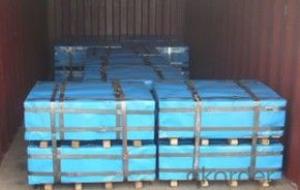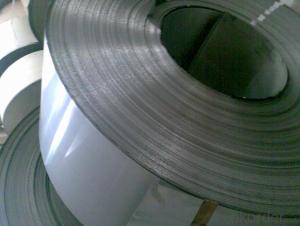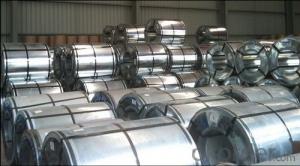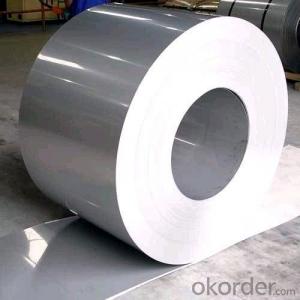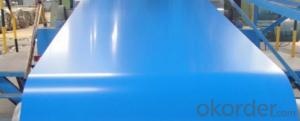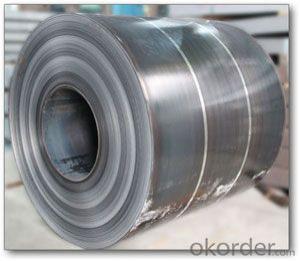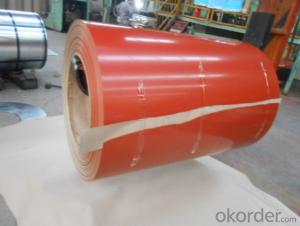BEATIFUL COLOR COATED ZINC STEELCOIL SHEET
- Loading Port:
- Tianjin
- Payment Terms:
- TT OR LC
- Min Order Qty:
- 25 m.t.
- Supply Capability:
- 20000 m.t./month
OKorder Service Pledge
OKorder Financial Service
You Might Also Like
Packaging & Delivery
| Packaging Detail: | seaworthy packing |
| Delivery Detail: | 25days |
Specifications
1). Zinc coat:60g-275g
2). Color: Any RAL colors to your demands.
3). Paint coating :Normal polyester coating.
PPGI color coated steel coil
Coil weight:4-8tons or according to the require of customor
Zinc coating:40-120g/Sqm
Paint:top paint 15-25mic,back:5-7um.
Color:RAL or as your sample.
Packing:seaworthy packng or as your require.
Technology:double hot double coating.
Equipment:south Korea imported.
1. The base metals for PPGI cold rolled HDG electro-galvanized and hot-dip alu-zinc coated steel. The finish coats of Prepainted Steel Coil can be classified into groups as follows: polyester, silicon modified polyesters, polyvinylidene fluoride, high-durability polyester, etc.
2. PPGI coated with organic layer, which provides higher anti-corrosion property and a longer lifespan than that of galvanized steel sheets.
- Q: What are the dimensions of steel coils?
- The dimensions of steel coils vary depending on factors such as the specific type of steel, the intended use, and industry standards. Generally, steel coils can range in width from a few inches to several feet, with thicknesses typically ranging from a fraction of an inch to several millimeters. The inner diameter of a steel coil can also vary, with common sizes being 20 inches and 24 inches. Ultimately, the dimensions of steel coils are determined by the specific needs and requirements of the end user.
- Q: What are the different methods of uncoiling steel coils?
- There are several methods used for uncoiling steel coils, including hydraulic uncoiling, motorized uncoiling, and manual uncoiling. Hydraulic uncoiling involves using hydraulic cylinders to unwind and release the tension in the coil. Motorized uncoiling utilizes a motorized mandrel or decoiler to unwind the coil. Manual uncoiling, on the other hand, requires physical effort to unwind the coil by hand. Each method has its own advantages and is chosen based on the specific requirements and capabilities of the uncoiling process.
- Q: Is steel with a black coloring as strong as regular steel. if you are asking why i have two wordsBlack Katana.I know a katana is not made with normal steel, it is made of two types with varying grades of carbon to give it speacial properties, i just want to know if the black will make a difference.
- There are many types of steel some very rigid, while you can have steel that is very flexible. The type of katana: steel is for Samurai swords
- Q: What are the different grades of steel used in coil manufacturing?
- There are several grades of steel used in coil manufacturing, including but not limited to, low carbon steel (e.g., ASTM A36), high carbon steel (e.g., ASTM A684), stainless steel (e.g., AISI 304), and galvanized steel (e.g., ASTM A653). These grades are chosen based on the desired properties and requirements of the coil being manufactured.
- Q: Why are properties of steel not identical?
- Grade 440C is one of the highest strength stainless steels. It is also very wear resistant. Good for use as ball bearings and other high wear applications. 400C has the highest carbon content of the 440 steels. 440A and 440B are identical but have lower carbon contents and have lower strengths and higher corrosion.
- Q: Can steel coils be coated with magnetically attractive materials?
- Yes, steel coils can be coated with magnetically attractive materials such as iron or nickel, allowing them to exhibit magnetic properties.
- Q: How does stainless steel soap work? I have read the detailed explanation on Wikipedia, but their desciption seems skeptical on the actual chemical process that may take place from using such an item. Is there an actual scientific explanation to how stainless steel soap is able to clean your hands, when it is only a piece of metal?
- Many metals have germicidal qualities. Silver is the strongest germicide of the metals, but a sterling silver bar of soap would be expensive and it would tarnish. The tarnish would actually not affect the silver's ability to kill bacteria, but it would look bad and the tarnish would turn your hands black, so people wouldn't want to use it. Many people even take silver internally in the form of Colloidal Silver, but Colloidal Silver is very controversial. Yes, it kills many bacteria, but it can also cause a person's skin to permanently turn blue...a condition called Argyria. Brass actually is a better germicide than stainless steel...but again this is a cosmetic problem. Brass tarnishes, so people wouldn't want to use it. Stainless steel is actually a very weak germicide, but even steel has some ability to kill germs. Stainless steel also removes fish odor. My son has a stainless steel bar that he takes along when he fishes to remove the fish smell from his hands. There's nothing magical about the bar...a stainless steel spatula would would just as well, but the bar is more convenient to carry. I'm not sure if this is scientific enough or not. -
- Q: What are the different coil edge options?
- There are several different coil edge options available, including open coil, continuous coil, offset coil, and pocket coil. Each type of coil edge offers unique features and benefits. Open coil edges are interconnected and provide a durable and supportive foundation. Continuous coil edges are made from a single piece of wire and offer enhanced stability and motion isolation. Offset coil edges have an hourglass shape for improved contouring and pressure relief. Pocket coil edges consist of individual fabric-encased coils that move independently, offering personalized support and minimizing motion transfer. Ultimately, the choice of coil edge depends on personal preferences and desired sleeping experience.
- Q: is red steel any good??????? not sure im really impressed but im not really into fighting games but it looks cool.... so whats your views guys???????anyone bored of smooth moves yet?anyone think the new sonic is bit cra ppy !!!!!!!!!!! darn them any new goooood games coming oput on the wii??
- Have you tried Zelda or Trauma Center? Those should give you a good ride for your money. If you have a few bucks lying around pick either of them up.
- Q: I personally don't believe the story of 8 guys who flew small planes can navigate passenger jets into buildings hundreds of miles away with that precision. It just doesn't make sense.I am wondering what the story surrounding the molten steel was, how could molten steel have been produced when fuel from the planes wasn't hot enough (it melts at 2850 degrees)?
- that's just it: there wasn't very much molten steel for the very reason you point out. Jet fuel burns at 800° to 1500°F. This is not hot enough to melt structural steel. However, engineers say that for the World Trade Center towers to collapse, their steel frames didn't need to melt, they just had to lose some of their structural strength. Steel will lose about half its strength at 1,200 degrees F. The steel will also become distorted when heat is not a uniform temperature. after the collapse, a LOT of folks took a look at the remains. the result was the conclusion that the fire caused the central core of the building to weaken. When the floors collapsed one on top of the other, the weight was too much for the weaked core to bear, causing the result we are all familiar with. hope this helps
Send your message to us
BEATIFUL COLOR COATED ZINC STEELCOIL SHEET
- Loading Port:
- Tianjin
- Payment Terms:
- TT OR LC
- Min Order Qty:
- 25 m.t.
- Supply Capability:
- 20000 m.t./month
OKorder Service Pledge
OKorder Financial Service
Similar products
Hot products
Hot Searches
Related keywords
